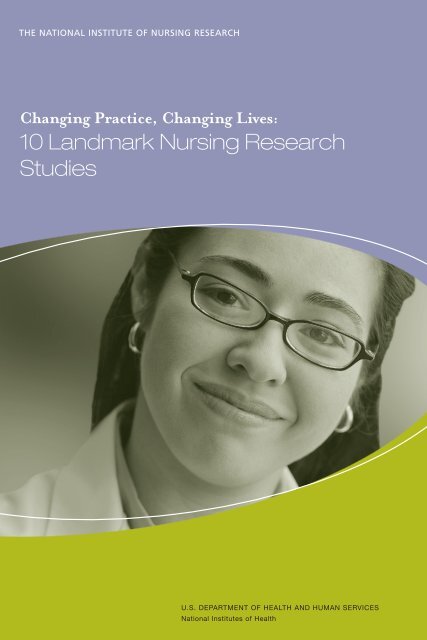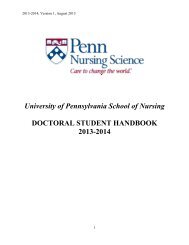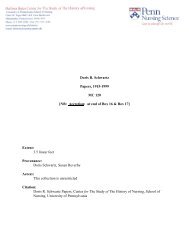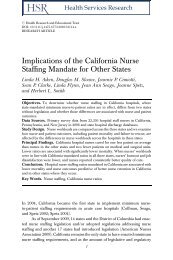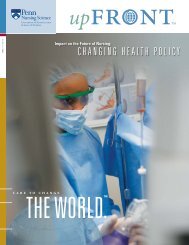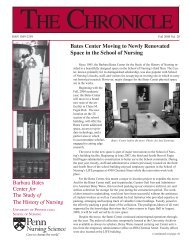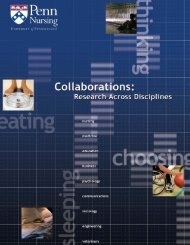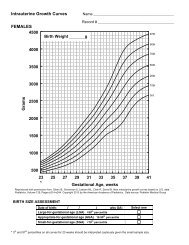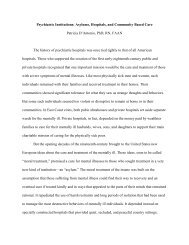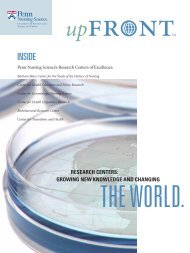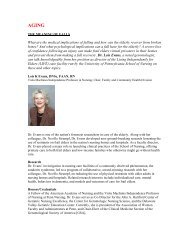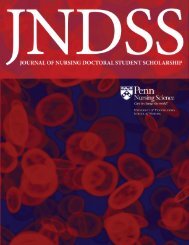10 Landmark Nursing Research Studies - National Institute of ...
10 Landmark Nursing Research Studies - National Institute of ...
10 Landmark Nursing Research Studies - National Institute of ...
Create successful ePaper yourself
Turn your PDF publications into a flip-book with our unique Google optimized e-Paper software.
THE NATIONAL INSTITUTE OF NURSING RESEARCH<br />
Changing Practice, Changing Lives:<br />
<strong>10</strong> <strong>Landmark</strong> <strong>Nursing</strong> <strong>Research</strong><br />
<strong>Studies</strong><br />
U.S. DEPARTMENT OF HEALTH AND HUMAN SERVICES<br />
<strong>National</strong> <strong>Institute</strong>s <strong>of</strong> Health
CHANGING PRACTICE, CHANGING LIVES:<br />
TEN LANDMARK NURSING RESEARCH STUDIES<br />
Introduction<br />
<strong>Nursing</strong> research gained a significant place in our Nation’s<br />
science and health care enterprise with the founding <strong>of</strong> the<br />
<strong>National</strong> Center for <strong>Nursing</strong> <strong>Research</strong> (NCNR) on the campus<br />
<strong>of</strong> the <strong>National</strong> <strong>Institute</strong>s <strong>of</strong> Health (NIH) in 1986. NCNR began<br />
to address the pressing research needs for nursing at that time,<br />
and by 1994 it became the <strong>National</strong> <strong>Institute</strong> <strong>of</strong> <strong>Nursing</strong> <strong>Research</strong><br />
(NINR). The year 2006 marked the <strong>Institute</strong>’s twentieth anniversary<br />
at NIH. This booklet presents ten landmark research studies<br />
that NINR has supported during its history. These studies helped<br />
establish the foundation <strong>of</strong> NINR’s work and illustrate the varied<br />
expertise <strong>of</strong> nurse researchers. They span issues that continue to<br />
be <strong>of</strong> great importance to nurses, such as symptom management,<br />
preventive health measures, health disparities, and the value <strong>of</strong><br />
nursing care.<br />
Since its beginning, the strength <strong>of</strong> NINR has been the talented and<br />
dedicated nurse researchers who have helped to build and develop<br />
nursing science. These studies demonstrate the versatility and vitality<br />
<strong>of</strong> the nursing research community, attributes that have been integral<br />
to nursing research since its early years and that nurse researchers can<br />
continue to pursue. As we have looked back on our landmark studies,<br />
we can see these attributes contribute to enhancing, informing, and<br />
guiding the biomedical and health care research mission <strong>of</strong> NINR.<br />
Changing Practice, Changing Lives: <strong>10</strong> <strong>Landmark</strong> <strong>Nursing</strong> <strong>Research</strong> <strong>Studies</strong> 1
Our health care system will face new and significant challenges as<br />
the 21st century progresses and our population continues to grow,<br />
age, and become more diverse. Many diseases that were once acute<br />
and life-threatening, such as heart disease, diabetes, and HIV,<br />
are now long-term chronic conditions. New global health threats<br />
continue to emerge. The examples presented in this booklet show<br />
that the research supported by NINR has been vital to addressing<br />
the wide-ranging and ongoing health needs <strong>of</strong> our nation. It is our<br />
sincerest hope that the foundation <strong>of</strong> solid science that NINR has<br />
built over the past 20 years will help nurse researchers meet new<br />
challenges in health care in the years to come. Our ultimate goal is<br />
to improve the health and well-being <strong>of</strong> all Americans.<br />
Patricia A. Grady, PhD, RN, FAAN<br />
Director, <strong>National</strong> <strong>Institute</strong> <strong>of</strong> <strong>Nursing</strong> <strong>Research</strong><br />
2 <strong>National</strong> <strong>Institute</strong> <strong>of</strong> <strong>Nursing</strong> <strong>Research</strong>
INADEQUATE NURSE STAFFING INCREASES<br />
RISKS FOR PATIENTS<br />
This research is helping to:<br />
PREDICT factors involved in hospital nursing care and patient safety;<br />
PERSONALIZE methods to promote safe hospital environments and<br />
nurse job satisfaction;<br />
PREEMPT adverse patient outcomes by promoting safe nurse working conditions<br />
and staffing levels.<br />
1<br />
The U.S. is experiencing a shortage <strong>of</strong> registered nurses (RNs).<br />
This shortage has been especially felt in hospitals, where over half<br />
<strong>of</strong> all nurses work. A survey in 2004 found the average vacancy<br />
rate for RN positions was over 16%. Over the next decade, as the<br />
population <strong>of</strong> the U.S. ages, many in the “baby boomer” generation<br />
will enter retirement. This is expected to generate a surge in health<br />
care needs due to the effects <strong>of</strong> aging and chronic illness. By the<br />
year 2020, the demand for nurses is projected to exceed the supply<br />
by 20%. However, the link between availability <strong>of</strong> RNs and the<br />
outcomes <strong>of</strong> hospitalized patients has not been well publicized or<br />
understood.<br />
Summary <strong>of</strong> <strong>Research</strong><br />
Dr. Linda Aiken, a pr<strong>of</strong>essor at the University <strong>of</strong> Pennsylvania and<br />
Director <strong>of</strong> the NINR Center for Health Outcomes and Policy<br />
<strong>Research</strong>, has conducted several studies that examined the impact<br />
<strong>of</strong> nursing within the health care system. In looking at “Magnet”<br />
hospitals (hospitals known for their success in attracting and retaining<br />
nurses) and AIDS care units, she consistently found that higher nurse<br />
staffing levels were related to lower patient mortality and increased<br />
patient satisfaction.<br />
Changing Practice, Changing Lives: <strong>10</strong> <strong>Landmark</strong> <strong>Nursing</strong> <strong>Research</strong> <strong>Studies</strong> 3
In a widely reported study from 2002, Dr. Aiken examined job survey<br />
results from over <strong>10</strong>,000 bedside nurses, in conjunction with hospital<br />
discharge abstracts <strong>of</strong> surgical patients. Results <strong>of</strong> the survey found<br />
that over 40% <strong>of</strong> the nurse respondents, who averaged <strong>10</strong> years <strong>of</strong><br />
experience, reported high job dissatisfaction and emotional exhaustion<br />
or burnout.<br />
The hospital data revealed that among post-operative patients, almost<br />
one-quarter experienced a major complication, and 2% died within<br />
30 days <strong>of</strong> admission. Compared to units with an average patient/nurse<br />
ratio <strong>of</strong> 4 to 1, units with lower staffing had a 7% increased risk <strong>of</strong><br />
patient death or failure-to-rescue (the development <strong>of</strong> a serious<br />
post-operative complication) for each extra patient assigned per<br />
nurse. An 8 to 1 ratio, the highest reported among the units in the<br />
study, increased the risk <strong>of</strong> adverse outcomes by 31%. In addition,<br />
poorer staffing intensified nurse dissatisfaction and burnout.<br />
Implications<br />
The round-the-clock presence <strong>of</strong> nurses on hospital units allows for<br />
surveillance <strong>of</strong> patient conditions and early detection and response<br />
to problems. Over the past decade, however, health care industry<br />
cost control measures have led to cuts in the nursing staff at many<br />
hospitals. These cuts, imposed at the same time that the Nation is<br />
experiencing a shortage <strong>of</strong> qualified, trained nurses, are driving some<br />
nurses from the pr<strong>of</strong>ession. Dr. Aiken’s studies are among the first<br />
to document the relationship between nurse staffing on hospital<br />
units and the outcomes <strong>of</strong> patients. A good work environment lowers<br />
nurse burnout and staff turnover, while it improves patient safety<br />
and satisfaction with care.<br />
According to Dr. Aiken, “Clearly, there is a direct relationship<br />
between nurse staffing and patient well-being. Nurse staffing is an<br />
issue that needs priority attention on a national scale. Patients’<br />
lives depend on it.”<br />
Reference<br />
Aiken LH, Clarke SP, Sloane DM, Sochalski J, Silber JH. Hospital nurse<br />
staffing and patient mortality, nurse burnout, and job dissatisfaction. Journal<br />
<strong>of</strong> the American Medical Association. 2002; 288: 1987-1993.<br />
4 <strong>National</strong> <strong>Institute</strong> <strong>of</strong> <strong>Nursing</strong> <strong>Research</strong>
DEVELOPING AN INDEX TO REDUCE<br />
PRESSURE SORE RISK<br />
2<br />
This research is helping to:<br />
PREDICT persons at risk for developing a pressure sore;<br />
PERSONALIZE care to maintain skin integrity for immobilized patients;<br />
PREEMPT the need to treat a pressure sore after it has developed, which <strong>of</strong>ten adds<br />
several days and tens <strong>of</strong> thousands <strong>of</strong> dollars to the cost <strong>of</strong> hospitalization.<br />
Pressure sores, also known as pressure ulcers or bed sores, represent<br />
a serious health problem in hospitals, nursing homes, and other<br />
health care settings. These sores develop when a bedridden or<br />
otherwise immobilized patient remains in one position for too<br />
long. The constant pressure reduces blood supply to the skin and<br />
underlying tissues, leading to tissue death and an open sore. More<br />
than 4 million people develop pressure sores each year, primarily<br />
the elderly and persons suffering a major injury or disease, adding<br />
roughly $9 billion in annual health care costs. Pressure sores<br />
also complicate patient care and delay recovery. The best treatment<br />
for pressure sores is prevention, and improved methods <strong>of</strong> assessment<br />
can help identify individuals at risk for pressure sores before<br />
they develop.<br />
Summary <strong>of</strong> <strong>Research</strong><br />
Dr. Nancy Bergstrom, currently at the University <strong>of</strong> Texas, Houston,<br />
began her research on pressure sores while at the University <strong>of</strong><br />
Nebraska. Dr. Bergstrom has collaborated with Dr. Barbara Braden to<br />
develop and test the Braden Scale for Predicting Pressure Sore Risk © .<br />
The Braden Scale is an instrument designed to help health care<br />
providers determine a patient’s risk for pressure sores. The patient is<br />
assessed and given a score in six areas: ability to change positions,<br />
physical activity capability, nutrition and hydration status, exposure<br />
Changing Practice, Changing Lives: <strong>10</strong> <strong>Landmark</strong> <strong>Nursing</strong> <strong>Research</strong> <strong>Studies</strong> 5
<strong>of</strong> the skin to moisture, exposure <strong>of</strong> the skin to friction or shearing<br />
during movement, and the ability to sense and respond to pressurerelated<br />
discomfort. The lower the overall score, the higher the<br />
pressure sore risk.<br />
Dr. Bergstrom tested the Braden scale in a multisite clinical trial<br />
involving tertiary care hospitals, Veterans Administration (VA) medical<br />
centers and skilled nursing facilities. None <strong>of</strong> the participants initially<br />
had pressure sores. Nurses assessed the participants using the Braden<br />
scale every two to three days over one- to four-week periods. During<br />
the study, roughly <strong>10</strong>% <strong>of</strong> the hospital or VA patients, and almost<br />
one-quarter <strong>of</strong> nursing home residents, developed a pressure sore.<br />
Patients with pressure sores were more likely to be older, white, and<br />
female. Findings supported the predictive value <strong>of</strong> the Braden scale<br />
to identify those patients at high risk for pressure sores.<br />
Implications<br />
The Braden scale is now widely used in nursing homes and hospitals<br />
all over the world. Dr. Bergstrom has chaired two panels <strong>of</strong> the<br />
Agency for Health Care Policy and <strong>Research</strong>, now the Agency for<br />
Healthcare <strong>Research</strong> and Quality (AHRQ), to determine best practice<br />
information on pressure sore prevention. Her research and knowledge<br />
about pressure sores was instrumental in writing Pressure Ulcers in<br />
Adults: Prediction and Prevention, and Pressure Ulcer Treatment, from which the<br />
current AHRQ clinical guidelines for prevention and treatment <strong>of</strong><br />
pressure sores were developed.<br />
Reference<br />
Bergstrom N, Braden B, Kemp M, Champagne M, Ruby E. Multi-site<br />
study <strong>of</strong> incidence <strong>of</strong> pressure ulcers and the relationship between risk level,<br />
demographic characteristics, diagnoses, and prescription <strong>of</strong> preventive<br />
interventions. Journal <strong>of</strong> the American Geriatrics Society. 1996; 44(1): 22-30.<br />
6 <strong>National</strong> <strong>Institute</strong> <strong>of</strong> <strong>Nursing</strong> <strong>Research</strong>
COPING SKILLS TRAINING IMPROVES<br />
TEENS’ SELF-MANAGEMENT OF DIABETES<br />
Type 1 diabetes, a disease that affects how the body uses sugar for<br />
energy, is one <strong>of</strong> the most prevalent chronic conditions among<br />
youths, affecting over 200,000 children and adolescents in the<br />
U.S. However, management <strong>of</strong> diabetes, which involves frequent<br />
testing <strong>of</strong> blood sugar levels and injections <strong>of</strong> insulin, <strong>of</strong>ten proves<br />
very difficult among adolescents. Uncontrolled, diabetes can lead<br />
to problems such as poor circulation, high blood pressure, kidney<br />
damage, and blindness. <strong>Research</strong> on teenagers with diabetes has<br />
shown they have difficulties in diabetes management, <strong>of</strong>ten in<br />
association with social situations involving peer pressure and fear<br />
<strong>of</strong> being seen as different.<br />
Summary <strong>of</strong> <strong>Research</strong><br />
Dr. Margaret Grey, dean <strong>of</strong> the Yale University School <strong>of</strong> <strong>Nursing</strong>,<br />
developed and tested an intervention called Coping Skills Training<br />
(CST) to improve diabetic teens coping and communication skills,<br />
healthy behaviors, and conflict resolution, in conjunction with routine<br />
diabetes management. This program was designed to increase teens’<br />
sense <strong>of</strong> competence and mastery by redirecting inappropriate or<br />
non-constructive coping styles into more positive behavior patterns.<br />
To study the effectiveness <strong>of</strong> CST in a randomized, controlled trial,<br />
the investigators divided a group <strong>of</strong> teens with type 1 diabetes into<br />
experimental and control groups. Both groups received intensive<br />
3<br />
This research is helping to:<br />
PREDICT behavioral problems associated with teens diagnosed with type 1 diabetes;<br />
PERSONALIZE coping strategies to promote diabetes management and quality <strong>of</strong> life;<br />
PREEMPT long-term complications from diabetes and other chronic illnesses.<br />
Changing Practice, Changing Lives: <strong>10</strong> <strong>Landmark</strong> <strong>Nursing</strong> <strong>Research</strong> <strong>Studies</strong> 7
diabetes management training to learn about their disease and how<br />
to handle it. The teens in the intervention group also received the<br />
CST in small class sessions, using role-playing to explore common,<br />
difficult situations they might face with friends. These included issues<br />
such as managing food choices, making decisions about drugs and<br />
alcohol, and facing interpersonal conflicts. Sessions lasted 60 to 90<br />
minutes weekly for six weeks, followed by monthly training visits.<br />
Both groups were followed for a year to assess their diabetes control<br />
and quality <strong>of</strong> life.<br />
The teens that received CST maintained better metabolic control,<br />
and showed a significant improvement in long-term blood sugar<br />
levels, compared to the control group. Just as important, they<br />
experienced a decrease in depressive symptoms and reported a better<br />
quality <strong>of</strong> life.<br />
Implications<br />
The benefits <strong>of</strong> behavioral interventions are evident, and the content<br />
<strong>of</strong> the CST program could benefit teenagers with other chronic<br />
conditions as they struggle through the turbulent years <strong>of</strong> puberty.<br />
So far, over <strong>10</strong>0 practices that manage the care for teenage diabetics<br />
have requested the CST manual developed by Dr. Grey and her team,<br />
to incorporate this training into their routine care. Furthermore,<br />
current clinical guidelines on the care <strong>of</strong> children and adolescents<br />
with diabetes emphasize the need for comprehensive behavioral care,<br />
not just disease management.<br />
As Dr. Grey has said, “<strong>Nursing</strong> research is about helping people deal<br />
with the hand that they’ve been dealt. People who have children with<br />
chronic illnesses have been dealt a bad hand. It’s very difficult to manage<br />
a child with something like diabetes. It takes a tremendous amount<br />
<strong>of</strong> effort on the part <strong>of</strong> the entire family. And so what we do is try to<br />
develop ways that help them manage very difficult situations better that<br />
lead to better outcomes for families as well as for the children.”<br />
Reference<br />
Grey M, Davidson M, Boland EA, Tamborlane WV. Clinical and psychosocial<br />
factors associated with achievement <strong>of</strong> treatment goals in adolescents with<br />
diabetes mellitus. Journal <strong>of</strong> Adolescent Health. 2001; 28 (5): 377-85.<br />
8 <strong>National</strong> <strong>Institute</strong> <strong>of</strong> <strong>Nursing</strong> <strong>Research</strong>
HELPING YOUTHS ESTABLISH HEALTHY<br />
HABITS OF EXERCISE AND DIET<br />
While cardiovascular disease (CVD) usually strikes adults over<br />
40 years <strong>of</strong> age, lifestyle behaviors that contribute to its development<br />
<strong>of</strong>ten begin in childhood. One major CVD risk factor is<br />
physical inactivity. Over one-quarter <strong>of</strong> adolescents say they are<br />
rarely involved in vigorous activities, and school-based physical<br />
education classes <strong>of</strong>ten do not provide adequate time or intensity<br />
<strong>of</strong> exercise. The rates <strong>of</strong> overweight and obesity among children<br />
are rising, <strong>of</strong>ten due to inactivity and poor nutrition. Children are<br />
increasingly found to have hypertension and elevated cholesterol.<br />
Smoking also tends to start during adolescence. Nurses working<br />
with children and teenagers can foster healthy lifestyle patterns to<br />
prevent the early development <strong>of</strong> CVD.<br />
Summary <strong>of</strong> <strong>Research</strong><br />
Dr. Joanne Harrell, pr<strong>of</strong>essor at the University <strong>of</strong> North Carolina<br />
at Chapel Hill, is the principal investigator for the NINR-funded<br />
Cardiovascular Health in Children and Youth (CHIC) studies.<br />
She has developed education and exercise programs that focus on<br />
improving physical activity and reducing long-term cardiovascular<br />
risks for use in schools across North Carolina, which has one <strong>of</strong> the<br />
highest rates <strong>of</strong> death from CVD and stroke in the U.S.<br />
An early CHIC study (CHIC I) involved over 1,200 elementary<br />
school students. In the program, the students received classes twice<br />
4<br />
This research is helping to:<br />
PREDICT youths at risk for cardiovascular disease (CVD) related to sedentary lifestyles;<br />
PERSONALIZE strategies to help youths stay active and develop heart-healthy habits;<br />
PREEMPT the early stages <strong>of</strong> CVD, obesity, type 2 diabetes, and other chronic<br />
conditions in school-aged children, providing health benefits throughout adulthood.<br />
Changing Practice, Changing Lives: <strong>10</strong> <strong>Landmark</strong> <strong>Nursing</strong> <strong>Research</strong> <strong>Studies</strong> 9
a week for eight weeks on the importance <strong>of</strong> exercise, selecting “heart<br />
healthy” foods, and the dangers <strong>of</strong> smoking. In addition, they participated<br />
in a physical activity class three times a week that involved fun,<br />
noncompetitive aerobic activities including jumping rope to music,<br />
group relays, and dancing. Compared to children in a control group<br />
that continued in their standard physical education classes, children<br />
in the CHIC program had significantly greater knowledge about<br />
healthy habits and reported more physical activity. They also lowered<br />
their cholesterol and body fat, increased their aerobic power, and had<br />
a smaller rise in their diastolic blood pressure than the controls.<br />
Implications<br />
A second CHIC study (CHIC II) tested interventions to increase<br />
health awareness and exercise habits in middle school students.<br />
Further research is ongoing with CHIC III, following previous CHIC<br />
participants and others through all stages <strong>of</strong> puberty to investigate the<br />
childhood development <strong>of</strong> several risk factors for CVD, obesity, and<br />
metabolic syndrome, a precursor to type 2 diabetes.<br />
According to Dr. Harrell, the CHIC studies have two major goals:<br />
(1) to determine the development and prevalence <strong>of</strong> cardiovascular<br />
risk factors in youth; and (2) to test interventions to reduce these<br />
risk factors and improve heart health for young people. The results<br />
<strong>of</strong> these studies indicate a need to place emphasis within elementary<br />
and middle schools on health and physical activity to reduce the<br />
long-term risks <strong>of</strong> CVD. Dr. Harrell has stressed that parents,<br />
teachers, and health care pr<strong>of</strong>essionals must help find ways for<br />
children to increase their amount <strong>of</strong> physical activity both during<br />
school and outside <strong>of</strong> school hours.<br />
Reference<br />
Harrell JS, McMurray RG, Bangdiwala SI, Frauman AC, Gansky SA, Bradley<br />
CB. Effects <strong>of</strong> a school-based intervention improve to reduce cardiovascular<br />
disease risk factors in elementary-school children: The Cardiovascular<br />
Health in Children (CHIC) Study. The Journal <strong>of</strong> Pediatrics. 1996; 128: 797-805.<br />
<strong>10</strong> <strong>National</strong> <strong>Institute</strong> <strong>of</strong> <strong>Nursing</strong> <strong>Research</strong>
A HEALTH CARE TEAM HELPS REDUCE<br />
HIGH BLOOD PRESSURE AMONG<br />
INNER-CITY BLACK MEN<br />
5<br />
This research is helping to:<br />
PREDICT susceptibility <strong>of</strong> persons with high blood pressure to early organ damage;<br />
PERSONALIZE strategies to promote disease management and cardiovascular health;<br />
PREEMPT long-term health risks from high blood pressure and related<br />
chronic conditions.<br />
High blood pressure (HBP), also known as hypertension, is the<br />
most common chronic disease among blacks in the U.S. and a<br />
major cause <strong>of</strong> disability and death, contributing to the mortality<br />
gap between blacks and whites. Uncontrolled, it can damage<br />
circulation to the major organs, most significantly the heart,<br />
kidneys, and brain. The management <strong>of</strong> HBP <strong>of</strong>ten involves<br />
behavioral changes and dietary modifications, along with a regimen<br />
<strong>of</strong> antihypertensive medications that require close follow-up from<br />
a health care provider. Black men living in urban or impoverished<br />
communities have a high incidence <strong>of</strong> HBP, and they generally<br />
have poor access to health services and <strong>of</strong>ten do not seek care or<br />
remain in treatment.<br />
Summary <strong>of</strong> <strong>Research</strong><br />
Dr. Martha Hill, the dean <strong>of</strong> the Johns Hopkins University School <strong>of</strong><br />
<strong>Nursing</strong>, led a research group that developed a three-year program<br />
involving a multidisciplinary health care team to provide care for<br />
inner-city black men with HBP. To evaluate the program, they<br />
recruited over 300 black men (average age 42 years) diagnosed with<br />
HBP and living in inner-city Baltimore. Although many <strong>of</strong> the men<br />
reported taking some form <strong>of</strong> antihypertensive medication, half had<br />
no health insurance or regular doctor, and fewer than one in five had<br />
achieved adequate BP control. Roughly one-quarter showed evidence<br />
<strong>of</strong> heart and/or kidney damage. This was especially significant given<br />
the relatively young age <strong>of</strong> the men.<br />
Changing Practice, Changing Lives: <strong>10</strong> <strong>Landmark</strong> <strong>Nursing</strong> <strong>Research</strong> <strong>Studies</strong> 11
The health care team taught all <strong>of</strong> the study participants about the<br />
benefits <strong>of</strong> HBP control, and all received free annual check-ups.<br />
Half <strong>of</strong> the men, serving as the control group, received referrals to<br />
community health care sources for ongoing HBP care. The rest<br />
were enrolled in the HBP team intervention. The health care team<br />
consisted <strong>of</strong> a nurse practitioner, a community health worker and<br />
a physician consultant. The team provided free antihypertensive<br />
medications and follow-up care, ongoing assessments, home visits,<br />
and referrals to social services and job training.<br />
At the conclusion <strong>of</strong> the study, men in both the control and the<br />
intervention groups showed decreases in smoking and consumption<br />
<strong>of</strong> salty foods. However, the men in the HBP team intervention<br />
showed a significant decrease in their systolic and diastolic pressures,<br />
with 44% lowering their blood pressure to within the normal range,<br />
and fewer signs <strong>of</strong> heart and kidney damage. They also reported more<br />
regular use <strong>of</strong> health care services and antihypertensive medications<br />
than the control group.<br />
Implications<br />
According to Dr. Hill, no previous hypertension studies had targeted<br />
high-risk, young urban black men, who are frequently underserved<br />
by the health care system. Participation in this study was the first time<br />
many <strong>of</strong> these men had come into contact with formal health care.<br />
They were pleased to be part <strong>of</strong> the research and to improve their<br />
health. By establishing a lasting, trusting relationship with these at-risk<br />
men, the health care team encouraged them to make lifestyle changes<br />
and maintain medication regimens that helped to improve their<br />
management <strong>of</strong> HBP.<br />
Dr. Hill said, “We used a comprehensive health care team approach<br />
with these men, who are considered hard to reach. The team approach<br />
was key to achieving control <strong>of</strong> hypertension and to retaining more<br />
than 90% <strong>of</strong> these men in the study protocol over three years’ time.”<br />
Reference<br />
Hill MN, Han H, Dennison CR, Kim MT, Roary MC, Blumenthal RS,<br />
Bone LR, Levine DM, and Post WS. (2003). Hypertension care and control<br />
in underserved urban African American men: behavioral and physiologic<br />
outcomes at 36 months. American Journal <strong>of</strong> Hypertension, 2003; 16: 906-913.<br />
12 <strong>National</strong> <strong>Institute</strong> <strong>of</strong> <strong>Nursing</strong> <strong>Research</strong>
REDUCING HIV RISK AMONG YOUNG<br />
MINORITY WOMEN<br />
6<br />
This research is helping to:<br />
PREDICT individuals and populations at high risk for HIV transmission;<br />
PERSONALIZE preventive strategies in developmentally and culturally sensitive ways;<br />
PREEMPT HIV transmission by promoting HIV awareness, abstinence, and<br />
safe sex practices.<br />
Infection with the human immunodeficiency virus (HIV), which<br />
can advance to Acquired Immune Deficiency Syndrome (AIDS),<br />
is a significant health problem in the U.S. and the world. The<br />
disease has spread to all populations, and heterosexual activity is an<br />
increasingly common mode <strong>of</strong> transmission. Cases <strong>of</strong> HIV/AIDS<br />
are increasing among younger people from 13 to 30 years <strong>of</strong> age.<br />
While new medications have extended the life <strong>of</strong> people with HIV,<br />
the disease has no cure. The key to defeating HIV lies with prevention.<br />
Educational programs are needed to reach and convince young<br />
people to reduce unsafe sexual practices and protect themselves<br />
from HIV, to help to slow or stop the spread <strong>of</strong> this and other sexually<br />
transmitted diseases (STDs).<br />
Summary <strong>of</strong> <strong>Research</strong><br />
Dr. Loretta Sweet Jemmott, pr<strong>of</strong>essor at the University <strong>of</strong> Pennsylvania<br />
and Director <strong>of</strong> the NINR Hampton-Penn Center to Reduce Health<br />
Disparities, has spent many years in the field <strong>of</strong> HIV/AIDS prevention.<br />
Her program <strong>of</strong> research, funded by a variety <strong>of</strong> sources including<br />
NINR, has focused on reducing risky sexual behavior, primarily<br />
among minority adolescents.<br />
An early NINR-funded program among adolescent black women<br />
included sessions on HIV/AIDS prevention and safe sexual practices,<br />
along with skills demonstrations emphasizing negotiation with a<br />
Changing Practice, Changing Lives: <strong>10</strong> <strong>Landmark</strong> <strong>Nursing</strong> <strong>Research</strong> <strong>Studies</strong> 13
partner and proper condom usage. The sessions were led by black<br />
nurses, and used audiovisual demonstrations, technical skill building<br />
demonstrations, role-playing, and discussions built around several<br />
themes: “Respect Yourself, Protect Yourself—Because You’re Worth<br />
It,” “Be Proud, Be Responsible,” and “Let’s Work Together to Save<br />
our People and Community.”<br />
Building on this program in a study funded by the <strong>National</strong> <strong>Institute</strong><br />
<strong>of</strong> Mental Health, Dr. Jemmott developed an educational intervention<br />
that delivered eight educational modules on sexual abstinence and<br />
safe sex practices to inner-city black middle school students. The study<br />
retained over 90% <strong>of</strong> its participants over the year-long period. Those<br />
who completed the modules were less likely to engage in sexual intercourse,<br />
and those who were already sexually active reported more consistency<br />
in their use <strong>of</strong> condoms and fewer episodes <strong>of</strong> unprotected sex.<br />
Implications<br />
Dr. Jemmott was among the first to show that educational interventions<br />
can help reduce risky sexual behaviors and to demonstrate their effectiveness<br />
in schools, health clinics, and other primary care settings.<br />
The educational programs are designed not only to increase awareness<br />
<strong>of</strong> HIV prevention but also to be entertaining, culturally sensitive,<br />
and gender appropriate. Based on the success <strong>of</strong> these programs, the<br />
Centers for Disease Control and Prevention (CDC) have used them<br />
as model curricula in their Division <strong>of</strong> Adolescent and School Health<br />
(DASH), and they are disseminated both nationally and internationally.<br />
Dr. Jemmott has been invited to South Africa to help decrease the<br />
impact <strong>of</strong> HIV/AIDS in Africa.<br />
Dr. Jemmott said, “For the past 15 years I have observed how the<br />
HIV/AIDS epidemic has disproportionately impacted the African<br />
American community, becoming convinced the incidence could be<br />
reduced if people changed their sexual behaviors. Our research has<br />
demonstrated remarkable success in reducing HIV risk-associated<br />
sexual behaviors among African American adolescents and adults.”<br />
Reference<br />
Loretta S. Jemmott, AIDS & black women—testing risk behavior interventions,<br />
NINR grant R01 NR03123.<br />
Jemmott JB 3rd, Jemmott LS, Fong GT. Abstinence and safer sex HIV riskreduction<br />
interventions for African American adolescents: a randomized<br />
controlled trial. Journal <strong>of</strong> the American Medical Association. 1998; 279(19): 1529-36.<br />
14 <strong>National</strong> <strong>Institute</strong> <strong>of</strong> <strong>Nursing</strong> <strong>Research</strong>
GENDER-BASED DIFFERENCES IN<br />
PAIN RESPONSE<br />
This research is helping to:<br />
PREDICT persons who can be helped by certain medications for pain;<br />
PERSONALIZE gender-based strategies to manage pain;<br />
PREEMPT the lower quality <strong>of</strong> life and increased disability related to chronic pain.<br />
7<br />
Pain is <strong>of</strong>ten viewed as an annoying symptom or a temporary,<br />
secondary consequence <strong>of</strong> illness or injury. However, pain is<br />
responsible for 40 million health care visits each year. It can delay<br />
recovery and impact daily functioning, and coping with chronic<br />
pain may become the consuming focus <strong>of</strong> a person’s life. This<br />
common symptom is particularly difficult to study because the<br />
perception <strong>of</strong> pain is highly subjective. In recent years, there<br />
has been an intensifying focus on understanding biological and<br />
psychological factors <strong>of</strong> pain. Pain is a very personal experience,<br />
and its treatment is a major public health concern.<br />
Summary <strong>of</strong> <strong>Research</strong><br />
Drs. Jon Levine and Christine Miaskowski <strong>of</strong> the University <strong>of</strong><br />
California at San Francisco began their studies in pain by seeking to<br />
identify a longer-acting acute pain medication than those currently<br />
available to reduce postoperative distress. Their research in humans has<br />
centered on postoperative pain management following dental surgery.<br />
The researchers tested the effects <strong>of</strong> nalbuphine, a member <strong>of</strong> a littleused<br />
class <strong>of</strong> medications called kappa-opioids, on women and men<br />
after surgery for wisdom tooth extraction. They found that women<br />
gained relief <strong>of</strong> their postoperative pain from a moderate dose <strong>of</strong><br />
nalbuphine, while both higher and lower doses had little effect when<br />
compared to a placebo. In men, only a high dose <strong>of</strong>fered slight,<br />
Changing Practice, Changing Lives: <strong>10</strong> <strong>Landmark</strong> <strong>Nursing</strong> <strong>Research</strong> <strong>Studies</strong> 15
short-term pain relief, while a low dose actually intensified the pain.<br />
Kappa-opioids have fewer negative side effects, such as nausea, confusion,<br />
and constipation, than the more commonly used mu-opioids like<br />
morphine. The difference in pain perceptions and responses between<br />
women and men uncovered in this study was an unexpected result.<br />
Implications<br />
Pain can exert a powerful influence on recovery from illness and on<br />
quality <strong>of</strong> life. Previously, most studies on pain have focused on men.<br />
This interesting finding revealed the importance <strong>of</strong> considering gender<br />
in providing medications and identified new directions for research<br />
on the experience and relief <strong>of</strong> pain.<br />
The research team continues to explore the exciting frontier <strong>of</strong> pain<br />
research, including studies on how pain is experienced and how it is<br />
relieved. The investigators plan to look at the brain mechanisms that<br />
underlie the gender differences in responding to kappa-opioid analgesia,<br />
how naloxone, an opioid blocker, is able to moderate these differences,<br />
and the effects <strong>of</strong> kappa-opioids in patients with many types <strong>of</strong><br />
chronic pain. In laboratory studies, this research team has also used<br />
a rat model to explore gender differences in the perception and<br />
response to pain and the role <strong>of</strong> the female hormone estrogen in<br />
pain signaling and peripheral pain receptors.<br />
Reference<br />
Gear RW, Miaskowski C, Gordon NC, Paul SM, Heller PH, Levine JD. The<br />
kappa opioid nalbuphine produces gender- and dose-dependent analgesia<br />
and antianalgesia in patients with postoperative pain. Pain. 1999; 83 (2):<br />
339-45.<br />
16 <strong>National</strong> <strong>Institute</strong> <strong>of</strong> <strong>Nursing</strong> <strong>Research</strong>
A COMMUNITY-BASED PROGRAM IMPROVES<br />
SELF-MANAGEMENT OF ARTHRITIS AMONG<br />
OLDER HISPANICS<br />
This research is helping to:<br />
PREDICT which individuals will benefit from self-management <strong>of</strong> arthritis;<br />
PERSONALIZE treatment options, especially among Hispanics in the U.S.;<br />
PREEMPT declines in health and the need for health care visits due to the<br />
effects <strong>of</strong> arthritis and other chronic conditions by improving patient control and<br />
self-management.<br />
8<br />
Chronic conditions such as arthritis, cardiovascular disease, and<br />
diabetes are the principal cause <strong>of</strong> disability in the U.S., and they<br />
account for a large percentage <strong>of</strong> all health care costs. Treatment<br />
plans <strong>of</strong>ten depend on patient self-management, which may involve<br />
strict medication schedules, diets, and exercise regimens, along<br />
with education programs that teach healthy behaviors, recognition<br />
<strong>of</strong> adverse symptoms, and coping with discomfort and disability.<br />
More than one in eight people in the U.S. are <strong>of</strong> Hispanic origin.<br />
Roughly one-fifth <strong>of</strong> Hispanics lack pr<strong>of</strong>iciency in English, which<br />
tends to isolate them from accessing or using community health<br />
resources, while nearly one-third lack any form <strong>of</strong> health insurance.<br />
Many older Hispanics do not have access to health care or to useful<br />
health information about chronic diseases, especially health materials<br />
written in Spanish.<br />
Summary <strong>of</strong> <strong>Research</strong><br />
Nurse scientist Dr. Kate Lorig <strong>of</strong> Stanford University in California<br />
and her research team have designed programs aimed at improving<br />
the health status, delaying deterioration, and reducing the need for<br />
health care visits related to chronic health conditions. Much <strong>of</strong> their<br />
initial work was devoted to arthritis, and resulted in the six-week<br />
Arthritis Self-Management Program, which helped to reduce pain<br />
and the need for physician visits while increasing the activity levels<br />
for arthritis sufferers.<br />
Changing Practice, Changing Lives: <strong>10</strong> <strong>Landmark</strong> <strong>Nursing</strong> <strong>Research</strong> <strong>Studies</strong> 17
Despite this success, the Arthritis program was not reaching the<br />
Hispanic population in the U.S., where arthritis is a leading cause <strong>of</strong><br />
disability. In order to make the courses available to all Spanish-speaking<br />
persons, Dr. Lorig developed a new program, based on her previous<br />
work, that included a six-week series <strong>of</strong> classes along with a book,<br />
Como Convivir con su Artritis (How to Live With Your Arthritis).<br />
Health care class leaders were recruited from the Hispanic community<br />
and received training to teach the course. The classes were held at<br />
local community sites. The book and the class materials contained<br />
detailed information in Spanish about self-management <strong>of</strong> arthritis,<br />
along with audiotapes to promote exercise and relaxation. Each class<br />
consisted <strong>of</strong> <strong>10</strong> to 15 people suffering from arthritis and also included<br />
additional family members who wanted to learn about the disease.<br />
One year after the program, a follow-up evaluation found that the<br />
study participants reported increased self-efficacy in managing their<br />
arthritis, improved activity levels and general health, decreased levels<br />
<strong>of</strong> pain, disability, and depression, and fewer visits to a physician,<br />
compared to a control group that received standard care.<br />
Implications<br />
Dr. Lorig expanded this work to develop a new program, Tomando<br />
Control de su Salud (Taking Control <strong>of</strong> Your Health), designed to<br />
address a variety <strong>of</strong> chronic conditions, including heart disease,<br />
hypertension, diabetes, and lung disease. Several organizations in the<br />
U.S. are now <strong>of</strong>fering this model <strong>of</strong> chronic disease self-management.<br />
In addition, the <strong>National</strong> Health Service <strong>of</strong> England has adopted it as<br />
a nationwide program and is presently implementing it in primary<br />
health care sites. In addition, organizations and communities in<br />
Canada, Europe, Australia, China, Taiwan, Japan, Korea, and South<br />
Africa are using her work. This self-management model is making a<br />
difference in the lives <strong>of</strong> chronically ill adults throughout the world.<br />
Dr. Lorig’s research continues to develop and evaluate communitybased<br />
self-management programs. She is now testing a course in<br />
Spanish specifically for type II diabetics that also includes telephone<br />
messages about managing the disease.<br />
Reference<br />
Lorig K, Gonzalez VM, Ritter P. Community-based Spanish language arthritis<br />
education program: a randomized trial. Medical Care. 1999; 37: 957-963.<br />
18 <strong>National</strong> <strong>Institute</strong> <strong>of</strong> <strong>Nursing</strong> <strong>Research</strong>
TRANSITIONAL CARE IMPROVES OUTCOMES<br />
FOR ELDERS AFTER LEAVING THE HOSPITAL<br />
This research is helping to:<br />
PREDICT problems in the transition <strong>of</strong> care for elders after hospital discharge;<br />
PERSONALIZE discharge planning and home care to individual health care needs;<br />
PREEMPT complications and rehospitalizations after elderly patients are<br />
discharged home.<br />
9<br />
With the aging <strong>of</strong> the population in the U.S., a greater number<br />
<strong>of</strong> older adults are living longer with chronic health conditions.<br />
Our current health care system tends to focus on acute care provided<br />
in hospitals. Less emphasis has been placed on home care after<br />
patients leave the hospital, where recovery and rehabilitation<br />
continues. Elders who are hospitalized for heart failure <strong>of</strong>ten<br />
have multiple medical conditions, symptoms, and medications,<br />
and they have the highest hospital readmission rate <strong>of</strong> all adult<br />
patient groups. This indicates a serious breakdown in continuity<br />
<strong>of</strong> care during the transition from the hospital to the home.<br />
Summary <strong>of</strong> <strong>Research</strong><br />
Dr. Mary Naylor, pr<strong>of</strong>essor at the University <strong>of</strong> Pennsylvania, has<br />
worked with an interdisciplinary research team looking into ways to<br />
improve the outcomes and reduce the costs <strong>of</strong> care for elders living in<br />
the community. Dr. Naylor and several collaborators have developed<br />
a transitional care model that employs advanced practice nurses<br />
(APNs) to provide hospital discharge planning and transitional care<br />
for a variety <strong>of</strong> vulnerable patient populations.<br />
In a randomized, controlled trial, Dr. Naylor and her team evaluated<br />
the effectiveness <strong>of</strong> the transitional care model in helping to maintain<br />
the health and function <strong>of</strong> elders with heart failure after hospital<br />
discharge. Roughly 80% <strong>of</strong> the elders had been hospitalized for a<br />
Changing Practice, Changing Lives: <strong>10</strong> <strong>Landmark</strong> <strong>Nursing</strong> <strong>Research</strong> <strong>Studies</strong> 19
sudden exacerbation <strong>of</strong> their condition, and the average length <strong>of</strong><br />
hospital stay was five days. Elders participating in the intervention<br />
received a three-month APN-led program designed to manage their<br />
discharge planning. The APNs worked with the patients to identify<br />
goals, individualize care plans and learning needs, coordinate care<br />
across the different settings from hospital to home, and implement<br />
an evidence-based protocol to manage the multiple health issues <strong>of</strong><br />
heart failure patients. A follow-up evaluation at one year showed that<br />
patients who had received the intervention had a longer time before<br />
first hospital readmission, along with fewer total rehospitalizations,<br />
hospital days, and deaths than the control group that continued in<br />
standard care. Improvements were also noted in patient satisfaction<br />
and quality <strong>of</strong> life. Although the APN program increased the initial<br />
cost <strong>of</strong> care, the total health care costs over the year-long study period<br />
were lower by almost $3,500 per patient for those in the intervention<br />
group, when compared to the control group.<br />
Implications<br />
The current health care system is <strong>of</strong>ten organized into separate areas—<br />
hospital, community, and home–but transitional care bridges this<br />
divide to promote better, cost-effective health care. The transitional<br />
care model <strong>of</strong>fers potential health benefits to patients at a lower total<br />
cost <strong>of</strong> care, although more study is needed. A major national health<br />
insurer is conducting a pilot program in New Jersey, Delaware and<br />
Pennsylvania to evaluate the success <strong>of</strong> transitional care.<br />
As Dr. Naylor states, “Nurses will play a pivotal role in addressing the<br />
health care needs <strong>of</strong> people throughout the 21st century. The cutting<br />
edge science, led by nurses and designed to advance knowledge related<br />
to promoting healthy lifestyles and caring for the chronically ill,<br />
will position nurses and other health team members to make a major<br />
difference in the lives <strong>of</strong> these people.”<br />
Reference<br />
Naylor MD, Brooten DA, Campbell RL, Maislin G, McCauley KM,<br />
Schwartz JS. Transitional care <strong>of</strong> older adults hospitalized with heart failure:<br />
a randomized, controlled trial. Journal <strong>of</strong> the American Geriatrics Society, 2004; 52:<br />
675-684.<br />
20 <strong>National</strong> <strong>Institute</strong> <strong>of</strong> <strong>Nursing</strong> <strong>Research</strong>
<strong>10</strong><br />
HOME NURSING VISITS BENEFIT LOW-<br />
INCOME MOTHERS AND THEIR CHILDREN<br />
This research is helping to:<br />
PREDICT the needs <strong>of</strong> young mothers at risk for pregnancy complications and<br />
children at risk for behavioral or developmental problems;<br />
PERSONALIZE pre- and post-natal care to help these women and their families cope;<br />
PREEMPT adverse pregnancy and child outcomes, and a continued cycle <strong>of</strong><br />
pregnancy and impoverishment in low-income or minority families.<br />
Unhealthy behaviors such as smoking, drinking, and drug use in<br />
young, high-risk pregnant women can lead to pregnancy complications<br />
such as high blood pressure or preterm labor, and to the delivery <strong>of</strong><br />
a premature or low birth weight infant. If continued after delivery,<br />
these behaviors can contribute to poor parenting that results in<br />
childhood developmental delays, injuries, or neglect, difficulties<br />
in achieving economic self-sufficiency, and additional pregnancies<br />
before the family can adapt. Promoting health and well-being among<br />
young, disadvantaged mothers and their children who are caught up<br />
in the cycle <strong>of</strong> poverty, neglect, domestic violence, substance abuse,<br />
and other health and social problems is a key issue in addressing<br />
health disparities for our nation.<br />
Summary <strong>of</strong> <strong>Research</strong><br />
A team <strong>of</strong> investigators led by Dr. David Olds, formerly <strong>of</strong> the University<br />
<strong>of</strong> Rochester and currently at the University <strong>of</strong> Colorado, developed a<br />
program that involved public health nurse visits to the homes <strong>of</strong> disadvantaged<br />
young pregnant mothers. These visits start before the child is<br />
born and continue through the early childhood period.<br />
Dr. Olds adapted a successful home nursing visit program originally<br />
developed in rural upstate New York for a group <strong>of</strong> over 1,000 lowincome<br />
black women in urban Memphis, Tennessee. Mothers in the<br />
Memphis program received an average <strong>of</strong> seven home visits from a<br />
Changing Practice, Changing Lives: <strong>10</strong> <strong>Landmark</strong> <strong>Nursing</strong> <strong>Research</strong> <strong>Studies</strong> 21
public health nurse during their pregnancy, along with 26 visits after<br />
delivery that continued through the child’s second birthday. The<br />
home visits were tailored to the needs <strong>of</strong> each family. Nurses provided<br />
prenatal care, taught parenting skills, linked the mothers to community<br />
services, and improved the mothers’ social support systems. Results<br />
indicated that many <strong>of</strong> the beneficial effects seen in the upstate New<br />
York study applied to the Memphis families as well. The mothers had<br />
significantly less pregnancy-induced high blood pressure, a common<br />
pregnancy complication, and they demonstrated better timing <strong>of</strong><br />
subsequent pregnancies. In the two years after delivery, childhood<br />
injuries were also substantially reduced.<br />
Implications<br />
Analysis <strong>of</strong> the New York study showed increased self-sufficiency<br />
<strong>of</strong> the families and reductions in Aid to Families with Dependent<br />
Children and Food Stamp payments. A follow-up study <strong>of</strong> the<br />
Memphis program found that when the children reached six years <strong>of</strong><br />
age (four years after the first study was concluded), they had higher<br />
IQ and language scores and fewer behavioral problems compared to<br />
similar children outside <strong>of</strong> the program, while the mothers showed<br />
lasting stability in family finances and relationships. This program<br />
<strong>of</strong> public health nurse visits is beginning to move from the research<br />
realm into public use.<br />
Dr. Olds currently directs the Prevention <strong>Research</strong> Center for Family<br />
and Child Health at the University <strong>of</strong> Colorado Health Sciences<br />
Center. The focus <strong>of</strong> this Center is to examine the long-term impact<br />
<strong>of</strong> this home nursing visit program on low-income, first-time mothers<br />
and their families. With funding from NIH, other federal agencies,<br />
and private philanthropies, the Center is conducting follow-up studies<br />
to evaluate how this program affects maternal economic self-sufficiency,<br />
parenting function, and substance abuse, as well as the behavioral<br />
outcomes, adaptive functioning, and productive life-course <strong>of</strong> the<br />
children as they enter adolescence and young adulthood.<br />
Reference<br />
Kitzman H, Olds DL, Henderson CR Jr, Hanks C, Cole R, Tatelbaum R,<br />
McConnochie KM, Sidora K, Luckey DW, Shaver D, Engelhardt K,<br />
James D, Barnard K. Effect <strong>of</strong> prenatal and infancy home visitation by<br />
nurses on pregnancy outcomes, childhood injuries, and repeated childbearing.<br />
A randomized controlled trial. Journal <strong>of</strong> the American Medical Association. 1997;<br />
278(8): 644-52.<br />
22 <strong>National</strong> <strong>Institute</strong> <strong>of</strong> <strong>Nursing</strong> <strong>Research</strong>
NIH PUBLICATION Changing NUMBER: Practice, Changing 06-6094Lives:<br />
Ten <strong>Landmark</strong> <strong>Nursing</strong> <strong>Research</strong> <strong>Studies</strong> c4


